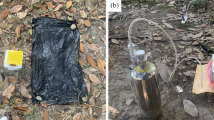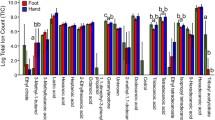Abstract
A dual-port olfactometer was used to quantify behavioral responses of the malaria mosquito Anopheles gambiae sensu stricto to volatiles emitted by sweat samples collected from three human volunteers. Significant attraction (P < 0.05) was found to sweat of two volunteers after two days and to one of the volunteers' sweat after one day of incubation at 37°C. There was no attraction to any of the fresh sweat samples. The pH of the sweat that became attractive after one or two days had changed from acidic (5.5–5.75) to alkaline (8.25–8.75), while the pH of the sweat of the third volunteer (pH 7) did not change during incubation. Microorganisms, present in all fresh sweat samples, showed distinct growth during incubation. The concentration of lactic acid decreased an average of 23% in two days of incubation. The role of the pH, skin microflora, and lactic acid in the differential attractiveness of human sweat samples is discussed.
Similar content being viewed by others
REFERENCES
Acree, J., Jr., Turner, R. B., Gouck, H. K., Beroza, M., and Smith, N. 1968. L-Lactic acid: A mosquito attractant isolated from humans. Science 161:1346-1347.
Bar-Zeev, M., Maibach, H. I., and Khan, A. A. 1977. Studies on the attraction of Aedes aegypti (Diptera: Culicidae) to man. J. Med. Entomol. 14:113-120.
Bergeim, O., and Cornbleet, T. 1943. The antibacterial action of the lactic acid and volatile fatty acids of sweat. Am. J. Med. Sci. 785-792.
Braks, M. A. H., Cork, A., and Takken, W. 1997. Olfactometer studies on the attraction of Anopheles gambiae sensu stricto (Diptera: Culicidae) to human sweat. Proc. Exp. Appl. Entomol. N.E.V. Amsterdam 8:99-104.
Cogan, T. M., and Daly, C. 1987. Cheese starter cultures, pp. 179-249, in P. F. Fox (ed.). Cheese: Chemistry, Physics and Microbiology, Vol. 1. Elsevier Applied Science, Amsterdam.
Cork, A., and Park, K. C. 1996. Identification of electrophysiologically active compounds for the malaria mosquito, Anopheles gambiae, in human sweat extracts. Med. Vet. Entomol. 10:269-276.
De Jong, R., and Knols, B. G. J. 1995. Olfactory responses of host-seeking Anopheles gambiae s.s. Giles (Diptera: Culicidae). Acta Trop., 59:333-335.
Eiras, A. E., and Jepson, P. C. 1991. Host location by Aedes aegypti (Diptera: Culicidae): a windtunnel study of chemical cues. Bull. Entomol. Res. 81:151-160.
Eiras, A. E., and Jepson, P. C. 1994. Responses of female Aedes aegypti (Diptera, Culicidae) to host odours and convection currents using an olfactometer bioassay. Bull. Entomol. Res. 84:207-211.
Geier, M., Sass, H., and Boeck, J. 1996. A search for components on human body odour that attracts females of Aedes aegypti. Proceedings, CIBA Foundation, No. 200: Olfaction in Mosquito-Host Interactions. Wiley, Chichester, pp. 132-144.
Khan, A. A., Maibach, H. I., Strauss, W. G., and Fisher, J. L. 1969. Increased attractiveness of man to mosquitoes with induced eccrine sweating. Nature 223:859-860.
Kline, D. L., Takken, W., Wood, J. R., and Carlson, D. A. 1990. Field studies on the potential of butanone, carbon dioxide, honey extract, 1-octen-3-ol, lactic acid, and phenols as attractants for mosquitoes. Med. Vet. Entomol. 4:383-391.
Knols, B. J. G. 1996. Odour-mediated host seeking behaviour of the Afro-tropical malaria vector Anopheles gambiae Giles. Thesis. Agricultural University, Wageningen, The Netherlands.
Knols, B. G. J., De Jong, R., and Takken, W. 1994. Trapping system for test olfactory responses of the malaria mosquito Anopheles gambiae in a windtunnel. Med. Vet. Entomol. 8:386-388.
Knols, B. G. J., Van Loon, J. J. A., Cork, A., Robinson, R. D., Adam, W., Meijerink, J., De Jong, R., and Takken, W. 1997. Behavioural and electrophysiological responses to female malaria mosquito Anopheles gambiae s.s (Diptera: Culicidae) to Limburger cheese volatiles. Bull. Entomol. Res. 87:151-159.
Mboera, L. E. G., and Takken, W. 1997. Carbon dioxide chemotropism in mosquitoes (Diptera: Culicidae) and its potential in vector surveillance and management programmes. Rev. Med. Vet. Entomol. 85:355-368.
MÜller, W. 1968. Die Distanz-and Kontakt-Orientierung der Stechmücken (Aedes aegypti) (Wirtsfindung, Stechverhalten und Blutmalzeit). Z. Vergl. Physiol. 58:241-303.
Noble, W. C., and Somerville, D. A. 1974. Microbiology and Human Skin. W. B. Saunders, London.
Parker, A. H. 1948. Stimuli in the attraction of Aedes aegypti, I., to man. Bull. Entomol. Res. 39:387-397.
Roessler, H. P. 1961. Versuche zur geruchlichen Anlockung weiblicher Stechmücken (Aedes aegypti L., Culicidae). Z. Vergl. Physiol. 44:184-231.
Schreck, C. E., Smith, N., Carlson, D. A., Price, G. D., Haile, D., and Godwin, D. R. 1981. A material isolated from human hands that attracts female mosquitoes. J. Chem. Ecol. 8:429-438.
Skinner, W. A., Tong, H., Pearson, T., Strauss, W., and Maibach, H. I. 1965. Human sweat compounds attractive to mosquitoes. Nature 207:679-680.
Sokal, R. R., and Rohlf, F. J. 1995. Biochemistry: The Principles and Practice of Statistics in Biological Research, 3rd ed. Freeman and Company, New York.
Stoddart, D. M. 1990. The Scented Ape, The Biology and Culture of Human Odour. Cambridge University Press, Cambridge.
Takken, W. 1991. The role of olfaction in host-seeking of mosquitoes: A review. Insect Sci. Appl. 12:287-295.
Thompson, R. P., and Brown, A. W. A. 1955. The attractiveness of human sweat to mosquitoes and the role of carbon dioxide. Mosquito News 15:80-84.
Thurmon, F. M., and Ottenstein, B. 1952. Studies on the chemistry of human perspiration with especial reference to its lactic acid content. J. Invest. Dermatol. 18:333-339.
Weiner, J. S., and Hellmann, K. 1960. The sweat glands. Biol. Rev. 35:141-186.
Author information
Authors and Affiliations
Rights and permissions
About this article
Cite this article
Braks, M.A.H., Takken, W. Incubated Human Sweat but not Fresh Sweat Attracts the Malaria Mosquito Anopheles gambiae sensu stricto. J Chem Ecol 25, 663–672 (1999). https://doi.org/10.1023/A:1020970307748
Issue Date:
DOI: https://doi.org/10.1023/A:1020970307748




